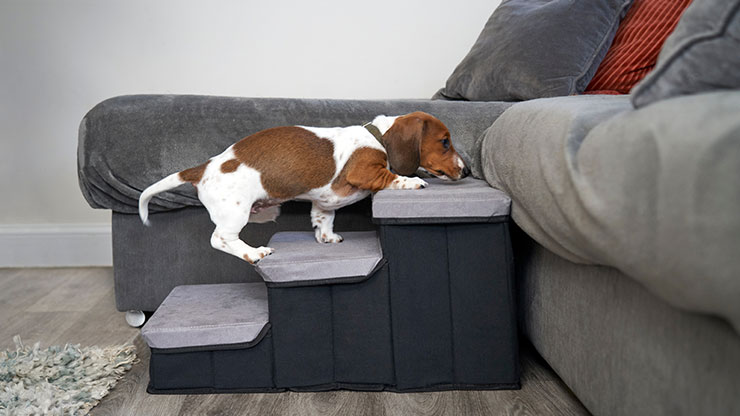
Caring for Your Senior Dog in Cold Weather
It can be challenging when your dog gets up in years, but you can modify their care so they can continue to enjoy life and be comfortable as a senior. This is particularly important during the winter when your dog can feel the colder temperatures a bit more and must be protected against the elements. You can take several steps to care for your senior dog in colder weather, and these tactics provide a great starting point.
Keep Your Dog Warm And Healthy
Staying outside in the cold for too long harms your pet's health and wellness. After too much time outside, your senior dog’s body temperature will fall, which can cause various health issues. The longer the dog is outside, the more likely the chances of heart issues, respiratory challenges, and a lack of blood flow to the brain.
Plus, older dogs are often more sensitive to temperature because their internal systems slow down, and it becomes more difficult to regulate body temperatures. Although you can’t keep the dog locked up all winter, don’t allow them to stay out too long, especially as the temperature drops. Walks should also be kept short on the coldest days.
Even if you limit your dog’s time outside, it’s still vital to take extra steps to keep them as warm as possible. One idea is to provide a comfortable and durable dog jacket. There are many options available that are suitable for different weather conditions. Raincoats can keep the dog warm and dry. There are also quilted jackets that provide an extra layer of warmth.

Exercise During Winter
Even if your dog is getting older, they still need to exercise and move just like aging adults should to stay fit and spry. If your dog is losing energy during its old age, you can give them a boost by providing food with less fat and more protein, which gives the body energy and improves their heart health.
There are many different ways that your dog can get the necessary amount of activity during winter. Play with your dog indoors with scent games that will keep their minds active and get them moving. You can play a box search game where you put several boxes on the floor, put treats in a few, and encourage them to search for the special boxes.
You can also exercise your older dog and keep them thinking by teaching them new tricks indoors. Whether it's rolling over a few times or going to obtain a specific item from the other room, you’ll keep them engaged while keeping them warm.
Walks outside are still crucial so they can move, sniff, and explore. Pay attention to the hourly weather report to determine the warmest times to go outside. Typically, the warmest part of the day is around noon, when there’s the most direct sunlight. So, while you may need to bring the dog out to the bathroom in the morning and night, use the time around noon to get in most of the playtime.
Bring the dog to the park and allow it to socialize with the other dogs. Try to keep the routine as regular as possible, and your dog can be happy through the winter season.
Keeping The Dog Healthy During Winter
Since your dog can feel the colder temperatures a bit more even while inside, it’s crucial to ensure that you’re watching their health throughout the season. Your dog’s joints can stiffen up during the winter, so make your pet’s days more comfortable by making it easier to get around. Consider putting steps near their favorite couch so it’s easier to get up. You can also provide them with a warm and supportive orthopedic bed.
There are also great supplements that can improve your pet’s wellbeing. Many of these products contain omega-3 fatty acids, which rejuvenate the pup’s skin and coat. Some supplements help rebuild the cartilage in the joints and reduce pain when your dog walks and runs. Pair supplements with regular exercise, and your dog will feel better.

Enjoy the Season
Inevitably, a lot of the preparations for winter weather with your dog may make you dread the season and its accompanying hassles. However, if your pup can enjoy this time of year, so can you. You simply need to find ways to make it more enjoyable.
You may feel cold during your daily walks with your dog, but embrace the Norwegian philosophy of “there is no such thing as cold weather, only bad clothes.” Prepare by investing in good quality cold-weather clothing, such as scarves, coats, sweaters, hats, and long underwear. The more layers you have, the better. You’ll also notice that gloves may come in handy as a nice additional layer of separation between you and your doggy poop bags.
Find time to express gratitude with your dog during this time as well. During the holiday season, shop for items your dog may enjoy. Maybe even buy a funny Christmas sweater for a holiday card. Or simply see life through their eyes as they trot in the pristine winter snow.
However, if you find yourself still feeling down despite these measures, know that you’re not alone. Seasonal Affective Disorder (SAD) is one of the many conditions you may experience during the winter time and affects thousands who live in colder environments. If you find that daily exercises like dog walks and the charismatic attitude of your dog still can’t raise your spirits, it may be time to seek the help of a professional and your support system.
By taking care of yourself, you’ll be more equipped to provide equal, if not more, care for your senior dog during the wintertime. Whether that means staying out longer for winter walks or simply having the mental wherewithal to buy them gifts during the holiday season, these simple strategies can go a long way to improving the quality of life for you and your senior dog.
Conclusion
Caring for a senior dog during winter takes a slightly different approach than the rest of the year, but the proper approach is crucial. Take the time to preserve the health of yourself and your pooch, and you’ll make it through the winter together.










